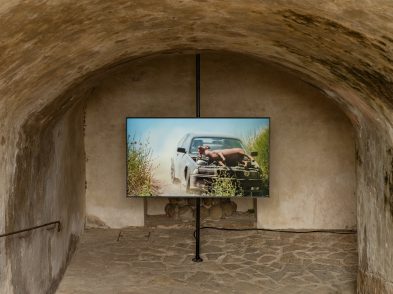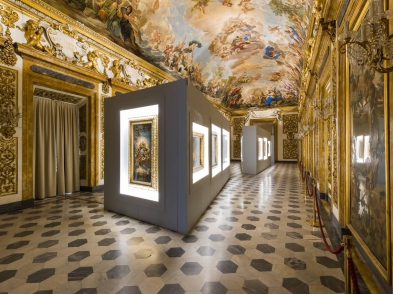Ketty La Rocca is now considered one of the most distinctive Italian artists of the 1970s. Yet in 1976, the year La Rocca died, aged 37, one leading American commentator wrote that she had been ‘unable to break into the male art world with her art and her writing.’ Only in recent times has the art world begun to acknowledge the contribution that women artists had long been making. As the significance of this creative individual, whose working life was spent in Florence, has become more widely recognised this century, appreciation of La Rocca’s importance in a radical decade has steadily risen. The first exhibition in the English-speaking world dedicated to her work took place in London in 2014.

Ketty La Rocca, Senza Titolo, 1974
As Jane Fortune’s extensive groundwork has demonstrated, women artists were largely denied professional recognition in Florence. For centuries, history attributed artistic advance almost exclusively to men.
This injustice persisted well into the last century. When contemporary art in Italy attracted worldwide interest in the 1950s and 1960s, the spotlight fell most often on figures such as Lucio Fontana, Alberto Burri and Piero Manzoni. Even the phenomenon of Arte Povera, which was closely attuned to the social changes of 1968, was predominantly male.
Yet intrinsic to the progress made in these years were the incisive ideas and alternative perspectives of women artists. Carla Accardi, who died last February, was an inspirational presence in Rome for 60 years; creating abstract environments, she constantly thought afresh about how art related to life. In Turin, Carol Rama and Marisa Merz have channelled feminine histories into the public consciousness through images resonant with first-hand knowledge.
In Florence, the interdisciplinary nature of Ketty La Rocca’s work placed her amid events typical of a tumultuous decade. Before her tragically premature death in 1976 from cancer, La Rocca pursued several careers—as radiographer, schoolteacher and mother—alongside developing her artistic vision. Each of these experiences informed the subjects and methods in which she immersed herself.
A native of La Spezia, her family moved to the Tuscan capital in 1949, when Ketty was aged 11. A prolific, self-taught artist, her first solo exhibitions took place around 1970 in Bologna, Milan and Florence. Although barely a trace remains today, Florence was then a centre for avant-garde architecture, poetry and music. Numerous exhibitions, at Alberto Moretti’s Galleria Schema and elsewhere, promoted progressive new work.
La Rocca showed her work at the Venice Biennale and in group shows abroad, especially in Germany and Austria. Although well known to fellow artists in Florence, it was only after her death that curators fully grasped the significance of her research. Before that could happen, a shift in perception was needed—not just in the art world, but in the wider society too.
Her creative individuality may have contributed to being under-appreciated for many years. While she dealt with the contemporary themes of feminism and counter-cultural politics, conceptual art and modern poetry, La Rocca remained independent of the era’s numerous ideological groups.

Ketty La Rocca, Le Scimmie, 1964-5, courtesy The of Estate Ketty La Rocca managed by the artist’s son, Michelangelo Vasta. Courtesy Wilkinson Gallery, London.
And although La Rocca was instrumental in introducing the conservative Italian art scene to alternative forms of expression, she came from outside the fine art’s established testing grounds. Consequently, she had to find her own way forward.
Her gender, however, was the biggest obstacle to her professional progress. Women, La Rocca wrote, ‘are robbed of everything, except of the things that no one notices and those are manifold’. Attitudes were slowly changing but society in the 1970s still strongly favoured men’s ambitions. For women artists navigating the art world, the serious attention of galleries and critics, collectors and even audiences, was hard won.
La Rocca’s journey bypassed the mainstream. In the early 1960s she became associated with Gruppo 70, writer-activists whose poesia visiva linked literature with structured typography to cluster words into dynamic forms. La Rocca took part in street events around the city and at the Feltrinelli bookshop in via Cavour.
At that time she worked with collage, a kind of flat graphic sculpting. Her images, demonstrably hand-made, echoed concerns, common among intellectuals in the mid-1960s, about the impact of consumerism on the quality of life. Photographs clipped from magazines were combined with slogans that satirised with humour and irony the aspirational language of advertising.
A particular target, at which she took aim with characteristic vigour, was the standard depiction of women in the hugely popular mass media of post-war Italy, as compliant homemakers or seductive temptresses in a male world.
Other institutions in her sightline were the Church and colonialism. One collage lampoons Europe’s condescending view of Africa that masqueraded as anthropological objectivity. A group of African boys observe two white women relaxing by a pool and, according to the caption, ask themselves: ‘Will the monkeys ever learn to talk?’
Yet her background also gave her a distinct advantage. Being free from orthodox academic approaches—by not knowing the rules—she was alert to experimenting with diverse techniques.
For instance, she had direct experience of technology. After gaining a teaching diploma in 1956, then working in schools and raising her son, La Rocca had been an assistant radiographer. She had also attended the Conservatorio Luigi Cherubini in Florence to study electronic music. Still in its infancy, the idiom used electromechanical instruments for sounds composed from mathematical forms.

Ketty La Rocca, Appendice per una supplica, 1974, photograph, Museum Ostwald, Dortmund
By 1970 her principal subject was communication and the body was her principal medium. Through photography, script, installation, video, book formats and live performance, all recently added to art’s resources, she explored ways to articulate contact beyond words, such as through movement.
For La Rocca was already analysing the role of words in perpetuating prejudice against women and people society placed on the margins. At the same time, it seemed that language itself was in danger of breaking down; modern life was reducing meaning to the rapid recognition of signs to obey – stop! turn right! buy this! Would conversation imitate this trend?
As La Rocca simplified her style with imaginative methods and by eliminating colour, her meaning intensified. At one point, she enlarged punctuation marks and single letters into plastic sculptures to populate the floor and wall—characters in every sense.
Typically she chose the letter j: rarely used in Italian, it is almost an outsider. But it is also related to i, as in the pronouns io or I that represent the self.
Eventually she dispensed with all words except one: tu and its English counterpart, you. For an artist who regarded communication between people as the centre of existence, its isolation implied a verbal intimacy that, like endangered species, was at risk.
Written repeatedly across the contours of an image, the word resembles an attempt to reclaim a memento or stitch a loosened bond. Words also imply sound, a beseeching cry or accusation. Already ill in the early 1970s, La Rocca wrote over x-rays of her own skull as if projecting a defiant, voiceless call from within the body itself.
Her involvement with deaf and mute children enabled her to observe information and feelings were exchanged without speech through touch and gesture.
Perhaps her most compelling images were black-and-white photographs made in 1974. Each shows a pair of hands making a shape, like sign language seeking its vocabulary. The experience of viewing a series of these image-gestures in a gallery is unforgettable: they highlight the transparency of human emotions. A silent desire to connect with another mind or body transcends the written word with undimmed resonance.






